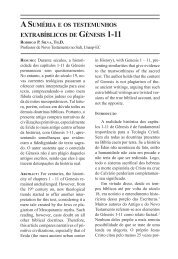genetica_de_populacoes
genetica_de_populacoes
genetica_de_populacoes
Create successful ePaper yourself
Turn your PDF publications into a flip-book with our unique Google optimized e-Paper software.
3. inversamente proporcional ao coeficiente médio <strong>de</strong> endocruzamento da<br />
população.<br />
Tabela 2.5. Fórmulas para calcular a proporção k esperada <strong>de</strong> filhos <strong>de</strong> casais com<br />
diferentes graus <strong>de</strong> consangüinida<strong>de</strong> entre os homozigotos <strong>de</strong> um gene autossômico a com<br />
freqüência q.<br />
Casal F Alto F Baixo<br />
Pai × Filha<br />
Mãe × Filho<br />
Irmãos<br />
Meio irmãos<br />
Tio(a) × Sobrinha(o)<br />
Primos duplos em 1 o . grau<br />
k =<br />
k =<br />
Primos em 1 o . grau<br />
Tio(a) × Meia(o) sobrinha(o) k=<br />
Primos em 2 o . grau<br />
Primos em 3 o . grau<br />
k=<br />
k=<br />
4[ F<br />
8[ F<br />
16[ F<br />
32[ F<br />
64[ F<br />
c(1 + 3q)<br />
+ (1 − F )q]<br />
c(1+<br />
7q)<br />
+ (1−<br />
F )q]<br />
c(1+<br />
15q)<br />
+ (1−<br />
F )q]<br />
c(1+<br />
31q)<br />
+ (1−<br />
F )q]<br />
c(1+<br />
63q)<br />
+ (1−<br />
F )q]<br />
k =<br />
k =<br />
k =<br />
k =<br />
k =<br />
c(1+<br />
3q)<br />
4( F<br />
8( F<br />
+ q)<br />
c(1+<br />
7q)<br />
16( F<br />
+ q)<br />
c(1+<br />
15q)<br />
32( F<br />
+ q)<br />
c(1+<br />
31q)<br />
64( F<br />
+ q)<br />
c(1+<br />
63q)<br />
Tabela 3.5. Proporções esperadas (k) <strong>de</strong> filhos <strong>de</strong> primos em primeiro grau entre os<br />
homozigotos <strong>de</strong> um gene autossômico com diferentes freqüências q, segundo várias taxas<br />
<strong>de</strong> casamento entre primos em primeiro grau (c) e diferentes valores <strong>de</strong> coeficiente médio<br />
<strong>de</strong> endocruzamento ( F ).<br />
q<br />
c = 0,005<br />
F = 0,005 F = 0,01<br />
c = 0,01<br />
F = 0,02 F = 0,005 F = 0,01<br />
c = 0,02<br />
F = 0,02 F = 0,005 F = 0,01 F = 0,02<br />
0,001 0,0529 0,0290 0,0152 0,1058 0,0580 0,0304 0,2116 0,1155 0,0605<br />
0,005 0,0338 0,0226 0,0136 0,0677 0,0452 0,0271 0,1347 0,0899 0,0540<br />
0,01 0,0242 0,0182 0,0122 0,0481 0,0361 0,0241 0,0962 0,0722 0,0482<br />
0,02 0,0163 0,0136 0,0103 0,0326 0,0273 0,0205 0,0653 0,0545 0,0410<br />
0,05 0,0100 0,0092 0,0080 0,0200 0,0184 0,0159 0,0400 0,0368 0,0317<br />
0,10 0,0075 0,0072 0,0066 0,0150 0,0143 0,0132 0,0299 0,0287 0,0265<br />
Se a proporção k <strong>de</strong> filhos <strong>de</strong> casais com um <strong>de</strong>terminado grau <strong>de</strong> consangüinida<strong>de</strong><br />
entre os homozigotos não for significativamente mais alta do que a freqüência c <strong>de</strong>sses<br />
k<br />
casais na população é evi<strong>de</strong>nte que a razão também não diferirá significativamente da<br />
c<br />
unida<strong>de</strong>. A investigação <strong>de</strong>ssa razão com base nos dados da Tabela 3.5 permite notar que,<br />
k<br />
para um <strong>de</strong>terminado coeficiente médio <strong>de</strong> endocruzamento, a razão é muito mais alta<br />
c<br />
quando o gene em estudo é raro do que quando ele é freqüente, in<strong>de</strong>pen<strong>de</strong>ntemente <strong>de</strong> a<br />
123<br />
+ q)<br />
115




